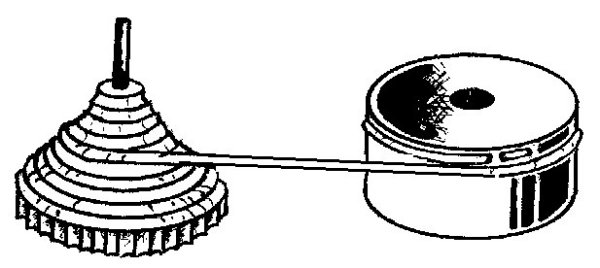Certain types of movements can be cleaned without being stripped down. Movements
should be stripped and examined for wear etc. but if you are convinced you will
never be able to reassemble the clock, then this is a poor but effective
alternative.
Cleaning a clock without stripping it down will not enable
you to examine and attend to the wear that has inevitably taken place. It will
not cure any faults, and may highlight others by removing the thickened oil on
which the mechanism now depends - albeit wearing it away. The oil may have
thickened by evaporation and absorbed small parts of metal, turning what was
once a useful lubricant into a grinding paste.
On no account should fusee
movements be cleaned by immersion without being stripped. Fusee is the term
given to the tapered barrel arrangement found in better quality clocks which
evens out the power of the spring as the clock runs down. Cheaper clocks tend to
go slower as the spring unwinds.
The Fusee Cone with line
The only types
that should be cleaned in this manner are:-
a. Weight driven movements
having had their gut or rope removed.
b. Spring driven clocks whose
mainsprings are not contained in barrels that restrict the flow of the cleaning
fluid. If you cannot clearly see the coils of the spring you will need to strip
down the clock.

Open spring
movement suitable for cleaning without stripping.
NB: A few types,
particularly quarter striking models, have provision for removing the mainspring
barrels without disturbing the rest of the mechanism.
Repairing Your Own Clocks by Mervyn Passmore